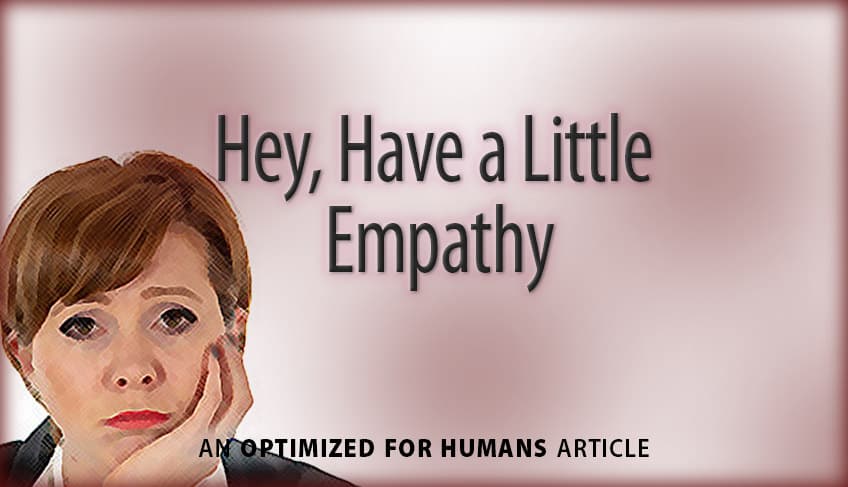
B Y T O M T O R T O R I C I
Everyone’s got problems.
We’re always trying to solve something, achieve something, or maintain something – but something else is standing in the way.
Overcoming those obstacles, from the trivial ones to the truly threatening ones, makes up a pretty good chunk of our daily lives.
All that resolving, achieving and maintaining is also the main reason we buy things.
In fact, the continuous stream of chronic needs and emerging dissatisfactions – among individuals and their organizations – essentially powers the world’s economy.
Put another way, as a provider of some product or service, resolving others’ problems is how you earn a living.
The funny thing is, you wouldn’t know that from most company’s websites. Yes, some businesses get it right. But so many miss the mark and wonder why the phones aren’t ringing.
Their websites talk about the types of things they sell. Clearly necessary, but not enough.
They talk about their brand’s mission, philosophy, history and values. They spend a lot of time getting the wording just right in expressing their company-insider point of view.
All understandable … from a company-insider point of view.
What they appear to be forgetting is that their website reader is on their own mission.
That hapless soul didn’t need another problem to solve, so there’s maybe a tinge of resentment there. Plus, if they haven’t solved their issue by now, they’re likely a bit frustrated. Maybe even anxious, if it’s important, or if there’s time-pressure, or if someone else in their lives is standing over their shoulder, tapping their foot.
So they go online, once again, looking for the perfect solution that matches their specific situation, without the downsides they keep running into.
What they find are companies that can’t stop talking about what they think of themselves. Along with a liberal sprinkling of broad, superficial marketing cliches.
Now, what if they finally land on a site where the provider seems to understand what they’re going through. Maybe the website copy recognizes the original trigger for their search, as well as the obstacles that have stymied their success. Not in terms of how the company sees ‘their’ customer. But how that human in search-mode sees themself.
What if the problem-solvers go a step further, to acknowledge the solution-seeker’s feelings?
They don’t have to overdo it, or get maudlin. They just have to recognize that humans don’t live – or make purchases – by logic alone.
Despite the colorful “Buy Now” or “Get Started” buttons that jump out as soon as you land on most websites, the initial response we really want from new visitors is “This company gets me.” Eliciting that unstated but visceral response, slowly drawing the visitor closer, is hands-down more powerful than a page of wall-to-wall clickable buttons.
In other words, if you show me you understand my problem (both the practical and emotional aspects), I’m more likely to believe you can solve my problem.
Purchase decisions almost always include a rational component and an emotional component.
Bullet-point lists of features help us logically compare vendors. A small dose of empathetic understanding taps into the feelings that triggered our search in the first place.
Calling a plumber for that burst pipe in your basement is a rational response, for sure. But how does that dire situation make you feel?
The thing is, companies’ front-line workers deal every day with people’s frustrations and dilemmas. But that cumulative intelligence typically doesn’t make it into their firm’s marketing appeals. Why?
Because the copywriter who interviewed the CEO asked superficial questions and got superficial answers. They should have dug deeper. They should have asked about the customers, not just the company.
Socially, we gravitate toward people who are genuinely understanding and empathetic toward us.
It’s just how we’re wired. Online, that bit of empathy can melt my natural “buyers’ armor” and create a bond that, in a marketing sense, is worth gold.
I guess the lesson here is, well, it is your company’s website. But you’re not the intended audience for that site. Maybe it’s time to dig deeper into the mindset, challenges, responsibilities, and aspirations of the folks who are in the market for what you sell.
Ask yourself, what might they be feeling?
And start there. Because if you position yourself to resolve both the practical issue and the emotional frustration, then you have twice as much to offer than your competitors.
Share It:
 About the Author: Tom Tortorici is an Atlanta copywriter and web content writer who helps companies make a genuine connection with their audience. His classes and conference presentations have focused on how writing, strategy and design can work together to grab attention and interest even among readers with short attention spans. In addition to working directly with businesses, Tom regularly partners with web designers and marketing agencies.
About the Author: Tom Tortorici is an Atlanta copywriter and web content writer who helps companies make a genuine connection with their audience. His classes and conference presentations have focused on how writing, strategy and design can work together to grab attention and interest even among readers with short attention spans. In addition to working directly with businesses, Tom regularly partners with web designers and marketing agencies.
All Posts/Subscribe >
Info for Businesses >
Info for Designers/Agencies >
Tom Tortorici Inc. | Tom@TomTortorici.com | 770-934-7861 | 3101 Rockaway Rd | Atlanta GA 30341

